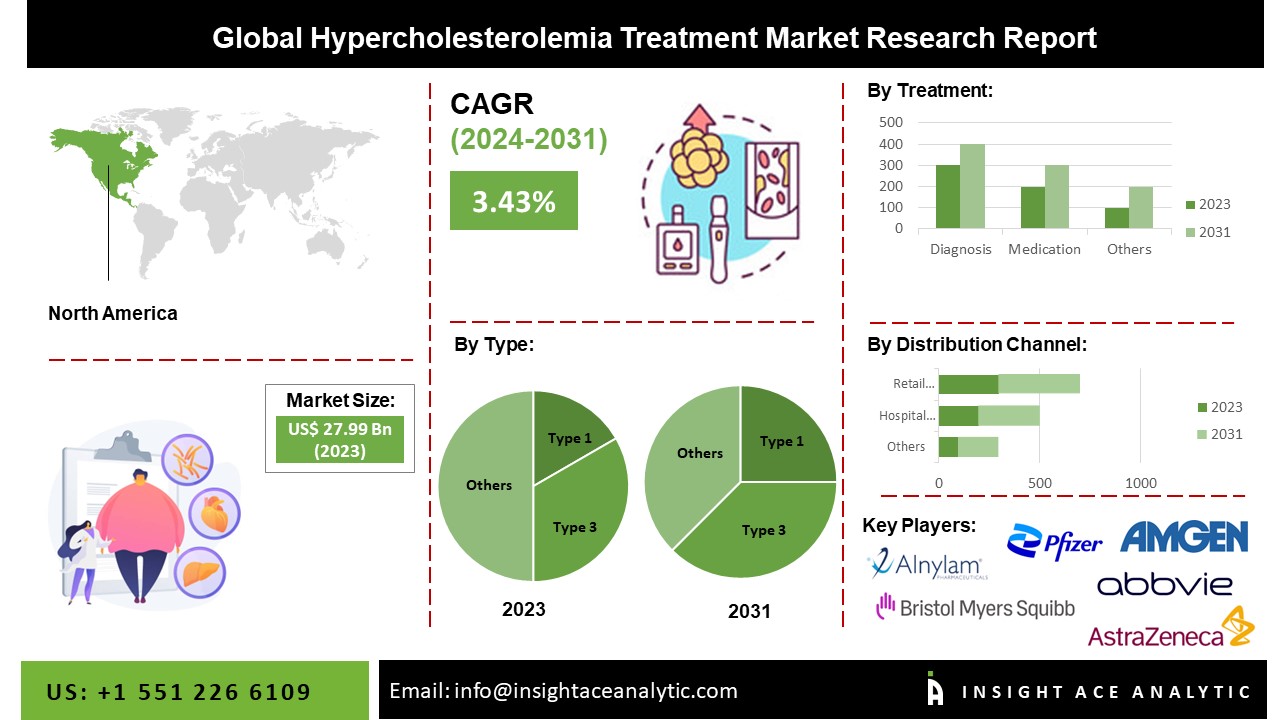The Hypercholesterolemia Treatment Market Size is valued at USD 27.99 Billion in 2023 and is predicted to reach USD 36.37 Billion by the year 2031 at a 3.43 % CAGR during the forecast period for 2024-2031.

Hypercholesterolemia is a hereditary disorder marked by abnormally high blood cholesterol levels. Hypercholesterolemia, sometimes referred to as dyslipidemia, is a form of hyperlipidemia and hyperlipoproteinemia in the body. Low-density lipoprotein cholesterol (LDL-C), or poor blood cholesterol, can cause cardiovascular problems. A mix of hereditary and environmental causes brings on hypercholesterolemia.
The rising incidence of cardiac disorders and their complications, along with technical improvements in the industry, are factors fueling the expansion of the market for hypercholesterolemia treatment. However, it is anticipated that the high therapy expenses and a shortage of qualified medical personnel will impede the market's expansion. Additionally, it is projected that rising government initiatives in the form of funding, tight rules, and increased awareness in the field of cardiology will spur market expansion.
Additionally, this market will rise during the next ten years due to the significant unmet demand for effective cholesterol treatment. Over the projected period, the worldwide hypercholesterolemia medication market will be driven by an essential rise in awareness of health concerns linked to elevated cholesterol levels as well as an increase in the prevalence of coronary diseases.
The hypercholesterolemia treatment market is segmented on the type, treatment, drug type, route of administration, end-user and distribution channel. Based on type, the market is segmented into type 1, type 2a, type 2b, type 3, type 4, type 5 and others. Based on treatment, the hypercholesterolemia treatment market is segmented into diagnosis, medication, physical therapy and others. Based on drug type, the hypercholesterolemia treatment market is segmented into branded and generics. Based on the route of administration, the hypercholesterolemia treatment market is segmented into oral, parenteral and others. Based on end-user, the hypercholesterolemia treatment market is segmented into hospitals, specialty clinics, home healthcare and others. Based on distribution channels, the hypercholesterolemia treatment market is segmented into direct tender, hospital pharmacy, retail pharmacy, online pharmacy and others.
Based on treatment, the hypercholesterolemia treatment market is segmented into diagnosis, medication, physical therapy and others. The medication category grabbed the highest revenue share, and it is anticipated that they will continue to hold that position during the anticipated time because statins are being used more frequently to treat hypercholesterolemia. The recommended and most well-known pharmacological therapy against hypercholesterolemia is statin therapy. Doctors have long used statin medications to treat hypercholesterolemia, hyperlipoproteinemia, and hypertriglyceridemia as a supplement to diet and exercise.
Based on end-user, the hypercholesterolemia treatment market is segmented into hospitals, specialty clinics, home healthcare and others. The hospital category is anticipated to grow significantly over the forecast period due to the increase of patients seeking treatment for hypercholesterolemia in hospitals. Hypercholesterolemic patients are advised to change their diet and engage in frequent physical activity. Hospitals' advanced infrastructure and qualified medical staff further foster this sector's expansion.
The North American hypercholesterolemia treatment market is expected to register the highest market share in revenue shortly, linked to escalating medical costs, growing public awareness, and a rise in the prevalence of hypercholesterolemia in the area. The number of people with hypercholesterolemia is increasing, there are more people seeking treatment, and there are more government initiatives to raise awareness. These are other factors driving the market's revenue growth in the area. Additionally, the Asia Pacific is anticipated to expand significantly over the forecast period due to the change in the existence of a sizable population. The market for treating hypercholesterolemia is increasing due to major key players that also influence the Hypercholesterolemia Industry Outlook in this region.
| Report Attribute | Specifications |
| Market Size Value In 2023 | USD 27.99 Billion |
| Revenue Forecast In 2031 | USD 36.37 Billion |
| Growth Rate CAGR | CAGR of 3.43 % from 2024 to 2031 |
| Quantitative Units | Representation of revenue in US$ Billion and CAGR from 2024 to 2031 |
| Historic Year | 2019 to 2023 |
| Forecast Year | 2024-2031 |
| Report Coverage | The forecast of revenue, the position of the company, the competitive market structure, growth prospects, and trends |
| Segments Covered | Type, Treatment, Drug Type, Distribution Channel, Route of administration, End-User |
| Regional Scope | North America; Europe; Asia Pacific; Latin America; Middle East & Africa |
| Country Scope | U.S.; Canada; U.K.; Germany; China; India; Japan; Brazil; Mexico ;The UK; France; Italy; Spain; China; Japan; India; South Korea; South East Asia; South Korea; South East Asia |
| Competitive Landscape | AbbVie, Inc., Bristol-Myers Squibb Company, Alnylam Pharmaceuticals Inc., Astrazeneca Plc, Merck & Co., Inc., Pfizer, Inc., Amgen, Inc., Eli Lilly and Company, GlaxoSmithKline plc, Novartis AG and Regeneron Pharmaceuticals Inc. |
| Customization Scope | Free customization report with the procurement of the report, Modifications to the regional and segment scope. Particular Geographic competitive landscape. |
| Pricing And Available Payment Methods | Explore pricing alternatives that are customized to your particular study requirements. |
By Type-
By Treatment-
By Drug Type-
By Route of Administration-
By End-User-
By Distribution Channel-
By Region-
North America-
Europe-
Asia-Pacific-
Latin America-
Middle East & Africa-